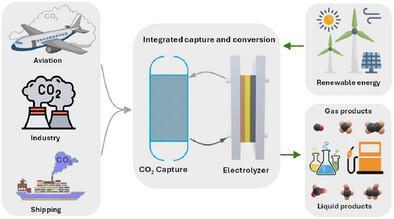Integrated Carbon Dioxide Capture and Electrochemical Conversion: Chemistry, Electrode and Electrolyzer Design, and Economic Viability
IF 26
1区 材料科学
Q1 CHEMISTRY, PHYSICAL
引用次数: 0
Abstract
Electrochemical carbon dioxide (CO2) conversion (ECC) offers a promising route to reduce CO2 emissions and to store renewable electricity in the form of chemical fuels. To date, ECC has been mainly based on pure CO2 gas isolated from carbon capture solutions, which is an energy-intensive step. Recently, direct CO2 conversion from a capture solution, which enables integrated CO2 capture and electrochemical conversion, has attracted attention because it can eliminate the energy-intensive CO2 isolation step. In addition, producing concentrated gas products in integrated systems reduces the cost for downstream separation. This review discusses the key aspects of integrated CO2 capture and electrochemical conversion systems, including direct air capture (DAC), the chemistry of CO2 capture and release, electrode designs and system configurations, as well as technoeconomic viability. First, the fundamental concepts and chemistry of CO2 capture and in situ CO2 release in electrochemical reactors are summarized. Then, recent advancements in integrated systems are discussed, covering both system configurations and electrode designs. Potential avenues for enhancing product selectivity toward high-value chemicals, such as ethylene and ethanol, as well as lowering operating cell voltages and improving the economic viability of integrated systems, are highlighted. Finally, major technical and economic challenges as well as emerging research opportunities in the domain of integrated CO2 capture and conversion are highlighted.

综合二氧化碳捕获和电化学转化:化学,电极和电解槽设计,和经济可行性
电化学二氧化碳(CO2)转换(ECC)为减少二氧化碳排放和以化学燃料的形式储存可再生电力提供了一条有前途的途径。迄今为止,ECC主要基于从碳捕获解决方案中分离的纯二氧化碳气体,这是一个能源密集型步骤。最近,从捕获溶液中直接转换二氧化碳引起了人们的关注,因为它可以实现二氧化碳捕获和电化学转换的集成,因为它可以消除能源密集型的二氧化碳隔离步骤。此外,在集成系统中生产浓缩气体产品降低了下游分离的成本。本文讨论了集成二氧化碳捕获和电化学转化系统的关键方面,包括直接空气捕获(DAC),二氧化碳捕获和释放的化学,电极设计和系统配置,以及技术经济可行性。首先,概述了电化学反应器中CO2捕获和原位CO2释放的基本概念和化学性质。然后,讨论了集成系统的最新进展,包括系统配置和电极设计。强调了提高产品对高价值化学品(如乙烯和乙醇)的选择性以及降低操作电池电压和提高综合系统的经济可行性的潜在途径。最后,强调了二氧化碳捕获和转化领域的主要技术和经济挑战以及新兴的研究机会。
本文章由计算机程序翻译,如有差异,请以英文原文为准。
求助全文
约1分钟内获得全文
求助全文
来源期刊

Advanced Energy Materials
CHEMISTRY, PHYSICAL-ENERGY & FUELS
CiteScore
41.90
自引率
4.00%
发文量
889
审稿时长
1.4 months
期刊介绍:
Established in 2011, Advanced Energy Materials is an international, interdisciplinary, English-language journal that focuses on materials used in energy harvesting, conversion, and storage. It is regarded as a top-quality journal alongside Advanced Materials, Advanced Functional Materials, and Small.
With a 2022 Impact Factor of 27.8, Advanced Energy Materials is considered a prime source for the best energy-related research. The journal covers a wide range of topics in energy-related research, including organic and inorganic photovoltaics, batteries and supercapacitors, fuel cells, hydrogen generation and storage, thermoelectrics, water splitting and photocatalysis, solar fuels and thermosolar power, magnetocalorics, and piezoelectronics.
The readership of Advanced Energy Materials includes materials scientists, chemists, physicists, and engineers in both academia and industry. The journal is indexed in various databases and collections, such as Advanced Technologies & Aerospace Database, FIZ Karlsruhe, INSPEC (IET), Science Citation Index Expanded, Technology Collection, and Web of Science, among others.
 求助内容:
求助内容: 应助结果提醒方式:
应助结果提醒方式:


